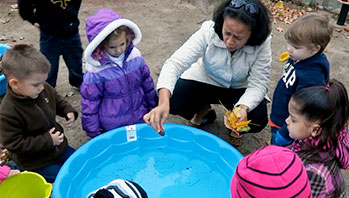- clipboard
- marker
- branch
- explore
- friend
- trunk
- twigs
MA Draft STE Standards
Life Sciences/From Molecules to Organisms/LS1/3.C: Use their sense in their exploration and play to gather information. [Structure and Function]
Life Sciences/From Molecules to Organisms/LS1/3.B: Identify the 5 senses as ways animals (including themselves) gather different kinds of information about the world around them. [Structure and Function]
Life Sciences/Ecosystems/LS2/4.C: Investigate local environments and infer/imagine how some living things might meet basic needs. [Structure and Function; Cause and Effect]
Life Sciences/Ecosystems/LS2/4.D: Determine the variety of living things in a local area and characteristics of the places where they were found.
Life Sciences/Ecosystems/LS2/4.E: Predict where they might find a familiar plant or animal and explain why they think so based on experience and knowledge of the organism. [Patterns]
Head Start Outcomes:
Science Knowledge/Scientific Skills & Method: Participates in simple investigations to form hypotheses, gather observations, draw conclusions, and form generalizations.
Science Knowledge/Conceptual Knowledge of Natural & Physical Worlds: Observes, describes, and discusses living things and natural processes.
PreK Learning Guidelines:
Science and Technology 10: Observe and identify the characteristics and needs of living things: humans, animals, and plants.
Science and Technology 11: Investigate, describe, and compare the characteristics that differentiate living from non-living things.
Science and Technology 15: Use their senses of sight, hearing, touch, smell, and taste to explore their environment using sensory vocabulary.
EEC:
PW50: The older toddler engages in a variety of physical activities.
Explore Together (outdoors): Explore Nature

© Commonwealth of Massachusetts, Department of Early Education and Care. All rights reserved.
Educator Prep: Prepare a safety rules chart to review when you go on outdoor explorations.
Safety Tips:
- Be aware of and check areas for poison ivy, poison sumac, nettles and thorns before taking children outside.
- Remind children to wash their hands before and after the activity.
- Remind children not to eat any plants or touch any plants without asking an adult.
- Children’s allergies need to be taken into account before going outside.
Tell children you are going to take them outdoors so they can explore their world with their friends, just like Peep and his friends did in the video.
Once outside, gather children around a large tree and ask, Do you remember what Peep found in a tree? (cat) Let’s see what you can find in and on and around the tree. Explain to children that they have to look closely and carefully as they explore. Ask questions such as:
- What do you think the tree will look like? Smell like? Feel like?
- What living things do you think you might we find in and around the tree?
- Think about the story Owl Babies we read. Do you think we will see owls in the tree? Why or why not? Why would an owl need to live in a tree?
- Point out the different parts of a tree and ask children to name them after you (trunk, branch, leaves, twigs). Continue to make connections to the Owl Babies story. Say, Who remembers what part of the tree the owl family lived in? (a hole in the trunk) What did the owls have in the hole in the tree? (twigs, leaves)
- Point to a big branch and make a connection to the branch the owls sat on while waiting for the Mommy to come back.
Allow children to freely explore and encourage them to draw or dictate to record their findings and to share their ideas with friends as they are exploring. As children continue to freely explore, prompt them to:
- Touch parts of the tree and describe how each part feels. After their descriptions, ask, Is there anything about the tree that feels or looks or smells different than what you thought?
- Look for living things, or evidence of living things, in and around the tree.
Reflect and Share Together
When you return inside, continue to make connections with children. Ask, Did you see anything that lives in a tree? Talk about the kinds of birds and animals that live in the trees in your neighborhood. Then invite children to share their observations and their recordings they made as they were exploring.
Educator Tip: If children can’t remember what they observed, give them a clue. Ask questions such as, We saw lots of holes in the leaves on the tree; where do you think the holes came from?
English Language Learners: As children explore outside, pantomime the words for the five senses they will use while exploring outside. For example, say smell, as you pick up a leaf to smell it. Have children repeat the action and the word after you.
